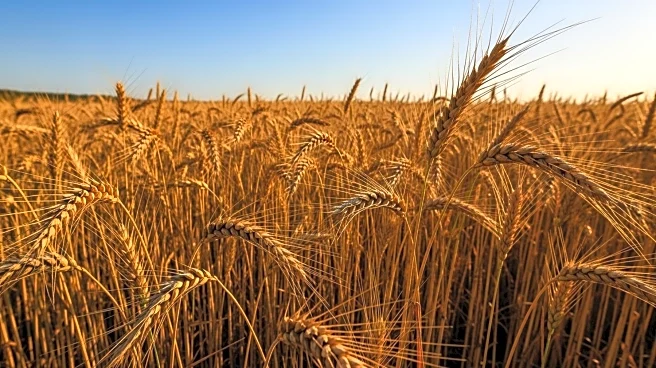What is the story about?
What's Happening?
The U.S. Department of Agriculture has forecasted global wheat production for the 2025-2026 marketing year at 806.9 million metric tons, an increase from the previous year's 799.9 million tons. Russian wheat production is projected to rise to 83.5 million metric tons, up from 81.6 million tons last year, with consultancy IKAR raising its outlook to 86 million metric tons. In the U.S., dry weather is aiding farmers in harvesting spring wheat, with 53% of the crop already harvested, slightly below the five-year average of 54%. The winter wheat harvest is nearly complete, with 98% collected. Wheat futures have been pressured by the increased global production, with September delivery prices dropping slightly.
Why It's Important?
The increase in global wheat production, particularly from Russia, could impact U.S. wheat prices and exports. As the U.S. continues its harvest, the pressure on wheat futures may affect domestic farmers' profitability. The rise in Russian wheat output could shift global market dynamics, potentially affecting trade relationships and pricing strategies. Additionally, the completion of the U.S. winter wheat harvest and progress in spring wheat harvesting are crucial for meeting domestic demand and export commitments, influencing the agricultural sector's economic stability.
What's Next?
U.S. farmers will continue to harvest spring wheat, with dry weather conditions expected to facilitate the process. Market analysts will monitor wheat futures closely as global production figures influence pricing. The USDA's projections may lead to adjustments in export strategies and domestic pricing policies. Stakeholders in the agricultural sector, including farmers and traders, will need to adapt to the evolving market conditions driven by increased global production.
Beyond the Headlines
The rise in Russian wheat production could have geopolitical implications, as agricultural exports are a significant component of Russia's economy. The U.S. may need to consider strategic responses to maintain its competitive edge in the global wheat market. Additionally, the impact of weather patterns on U.S. harvests highlights the importance of climate considerations in agricultural planning and policy-making.
AI Generated Content
Do you find this article useful?















